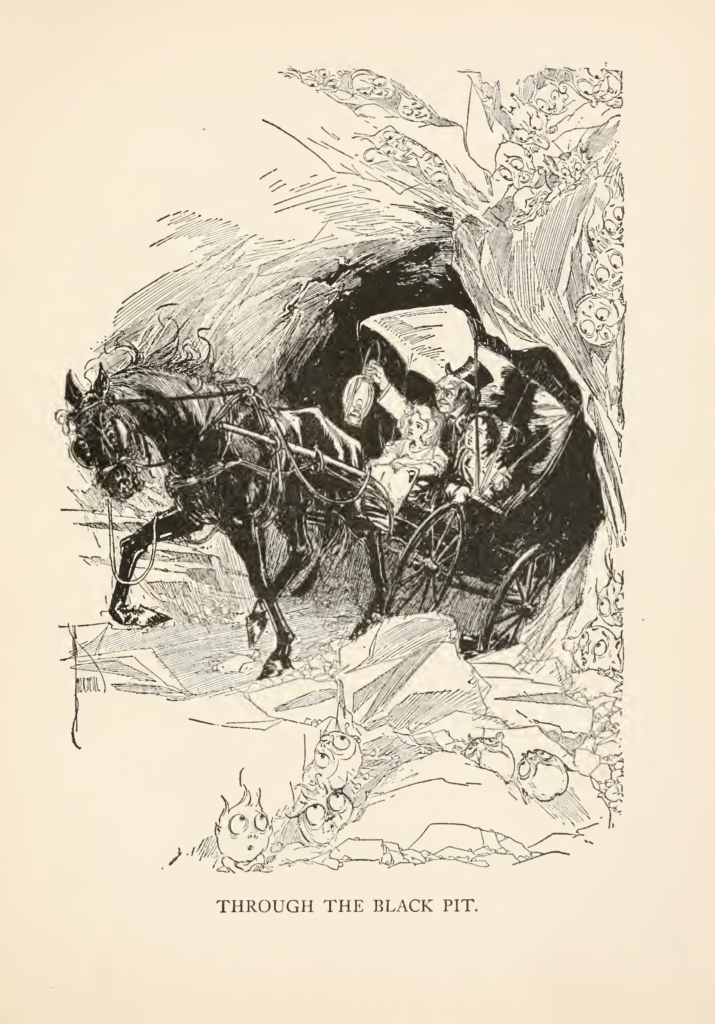Despite a human-like exterior, the Mangaboos’ innards resemble those of a potato. Dorothy discovers this when the Wizard of Oz chops their Sorcerer clean in half: “Dorothy screamed and expected to see a terrible sight; but as the two halves of the Sorcerer fell apart on the floor she saw that he had no bones or blood inside of him at all, and that the place where he was cut looked much like a sliced turnip or potato” (52).

The adventures Baum invents this time around are darker and more violent than before—extremely creative, too. This is the first Oz book to explicitly describe blood and wounds: “when he drew back the blade it was dripping with blood” (116). And whereas, in Ozma of Oz, Baum was averse enough to death and killing that nobody dies in the battle against the Nome King’s soldiers (except, presumably, all the soldiers whom Dorothy transforms into eggs), this time around, as the above-mentioned scene where the Wizard kills the Sorcerer proves, Baum is feeling less hospitable. The battle against the Wooden Gargoyles only avoids death because the enemy is animated wood, though the Wizard casually remarks that he might have completely wiped out their entire people: “the Gargoyles never will be missed” (161). Earlier, Baum is explicit that the Wooden Gargoyles, however mean, are in fact people rather than mindless monsters: “the most amazing things of all were the wooden people—the creatures known as Gargoyles” (136). The Gargoyles live in little houses and construct cute gardens and everything. This is the first sign of Baum’s real-world pro-genocide stance I have noticed in his stories, and I hope it will be the last. (Unless we take Dorothy living in Kansas and the very existence of the US to suggest genocidal politics, in which case the theme is pervasive!)
In my Ozma of Oz post, I reflected on a general subdued lack of emotion in the Oz novels. But Dorothy and the Wizard in Oz makes the peril feel legitimately perilous. The characters are concerned about the stakes in the story instead of lightheartedly bumbling through them. Consider the fall into the chasm that begins the story. Baum describes their fall like this: “The sudden rush into space confused them so that they could not think” (21). Then: “The horrible sensation of falling, the darkness and the terrifying noises, proved more than Dorothy could endure and for a few moments the little girl lost consciousness. Zeb, being a boy, did not faint, but he was badly frightened, and clung to the buggy with a tight grip, expecting every moment would be his last” (21–22). Ignoring that implication that only girls faint, uncharacteristic of a series where girls are consistently as tough as boys, Baum describes the scene in vivid, frightening language and has his characters actually respond with emotions. Compare that to Dorothy being blown overboard in Ozma of Oz:
After coughing the water out of her throat and getting her breath again, she managed to climb over the slats and stand upon the firm wooden bottom of the coop, which supported her easily enough.
“Why, I’ve got a ship of my own!” she thought, more amused than frightened at her sudden change in condition[.]
[…] “Well, I declare!” she exclaimed, with a laugh. “You’re in a pretty fix, Dorothy Gale, I can tell you! and I haven’t the least idea how you’re going to get out of it!” (20).
Even Baum’s acknowledgment of her danger assumes the shape of gentle humor: “It was lucky for Dorothy, I think, that the storm subsided; otherwise, brave though she was, I fear she might have perished” (22).
In contrast, in Dorothy and the Wizard in Oz, there is no attempt to soften Dorothy and Zeb’s fate up to the moment it is clear (though a foregone conclusion) that they are in for another magical adventure.
Also take the above description of Dorothy’s response to seeing the Wizard kill the Sorcerer: she “screamed” and “expected to see a terrible sight,” already more emotional detail than usual. Another instance is when the Wizard, Dorothy, and Zeb respond to the Mangaboos burying the animals in the dreaded Black Pit, where they bury all their enemies alive. Already a particularly frightening scene in a dark and unsettling world, this is what happens:
Before long they neared the Black Pit, where a busy swarm of Mangaboos, headed by their Princess, was engaged in piling up glass rocks before the entrance.
“Stop, I command you!” cried the Wizard, in an angry tone, and at once began pulling down the rocks to liberate Jim and the piglets (90).
The Wizard shouts, he “cries” in an “angry tone,” and “at once” takes action that reflects his emotions. You can tell he cares about what is going on. After a skirmish (the Mangaboos use thorny plants as weapons), Dorothy and the others are also trapped in the Black Pit, watching the Mangaboos block the entrance with glassy vegetable debris. The Wizard says, “My dears, what shall we do? Jump out and fight?” But Dorothy responds, “What’s the use? I’d as soon die here as live much longer among those cruel and heartless people” (92). The characters seem genuinely upset with their situation. I do not claim any of this is particularly extraordinary writing. But it gives off more emotion than the earlier adventures. Instead of a twee line about being in a pretty fix, Dorothy expresses despair and just plain frustration with their continuous mistreatment.
